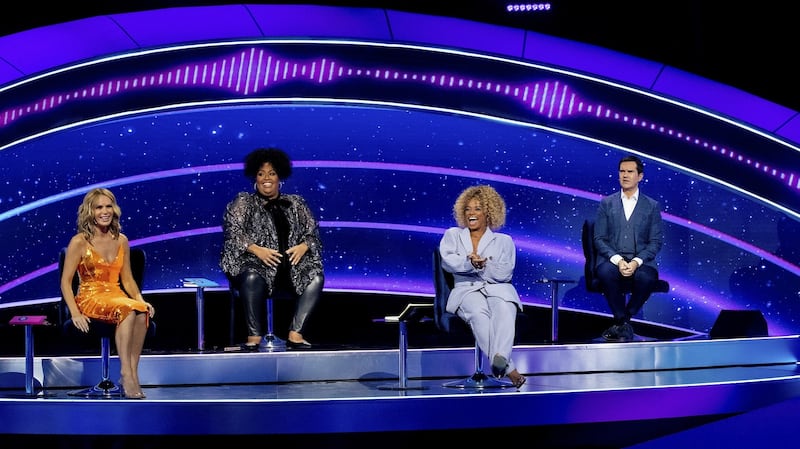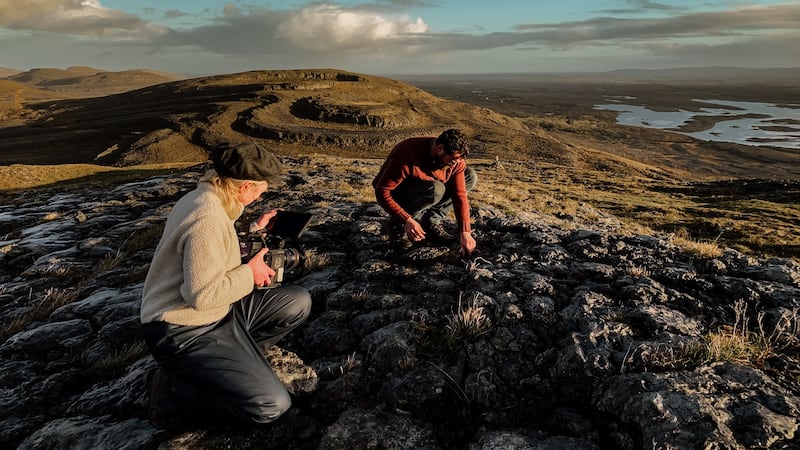Paddy McGuinness has amassed great power in the world of light entertainment. His hair has gone blond with this power. He is lord of all he surveys, and what he surveys are shiny-floor gameshows with titles such as How Many Spoons? and Wobble Ball and Funsplosion 3000. (These are not the actual gameshows he hosts, but my broadband is down.)
He still wears a suit but has outgrown the concept of shirts and now wears a T-shirt beneath his jacket, because he doesn't give a damn. McGuinness is the obvious presenter for I Can See Your Voice (Saturday, BBC One), a programme in which a panel of celebrities drop acid and see what happens. Well, I assume that's what it's about.
Update: I have now watched the whole show, and the celebrities do not drop acid and see what will happen (but I have copyrighted that idea, and it will be out next year with the title Everything Is Connected, Deborah, I Understand That Now, also presented by Paddy McGuinness).
I bet Danny from McFly is thankful he's not on the show where they have to guess which randomer is capable of open-heart surgery or defusing a bomb. But they make trying to figure out whether strangers can sing look like good fun
In I Can See Your Voice, contestants try to ascertain if strangers can or can’t sing while celebrities chip in with advice. Once upon a time, gameshows involved some manual dexterity or general knowledge. Now they test contestants on extremely niche skills, such as, in the case of This Is My House (a real programme), the ability to detect if someone is lying about owning a house, and now, in I Can See Your Voice, the ability to detect if someone is lying about being able to sing.
Perhaps that is a much sought-after skill in a world of abstracted labour and nonsensical surveillance. What do you do for a living? “I determine whether someone can sing by looking at them, and then I rat them out to Paddy McGuinness at the Ministry of Truth.”
At the outset of the episode, the six potential singers stand on podiums while the contestants, a married couple named John and Lee, assess their singing ability based on their stance, clothing and spurious backstories. This motley assortment includes a teacher, a dance diva and a rugby player. John and Lee are assisted in this endeavour by four celebrities sitting on socially distant seats, like punished children.
There's the congenital funnyman Jimmy Carr, who likes to honk and clap like a happy seal. There's Amanda Holden, who has been on celebrity panels for so long now I can't remember for what she was originally famous. There's the charming Alison Hammond, runner-up in the third series of Big Brother, which makes her a venerated figure in the world of contemporary light entertainment. And, finally, there's the guest panellist Danny Jones, from McFly, a boy band beloved by Caledonian entomologists.

John and Lee will, with their help, whittle the six possible singers down to one singer, who will, skilled or not, sing with Danny at the end of the show. I bet Danny’s thankful he’s not on the show where they have to guess which randomer is capable of open-heart surgery or defusing a bomb. That said, they make trying to figure out whether strangers can sing look like good fun.
“The microphone is in a good position. She’s holding that well,” says the ageless, eternal panellist Amanda Holden, wisely.
Occasionally, Paddy McGuinness chips in to remind us what a confusing concept this is: “Remember, everything the good singers say is true and the bad singers are only lying about their singing experience.”
At the end of the first round, John and Lee wish to hear the vocal stylings of a man they dub “the Party King”. The Party King opens his mouth and we hear the very pits of hell emerge and lose hope. John and Lee are thrilled by this abomination, for they have unmasked a non-singer. He is taken outside and presumably imprisoned or sedated.
Next comes a round in which the remaining contestants lip-sync to pitch-perfect renditions of popular songs, though some of them are lip-syncing to their own excellent voices while others secretly croak along to the tunefulness of others.
For now, we're stuck with sitting at home watching you guessing whether strangers can sing
This bit must be extraconfusing to young people. If I know anything about popular culture, it’s that for the youth of today lip-syncing is the ultimate art form. For that cadre of screen-conjoined digital natives, singing is something that the ancients used to do on unre-creatable audio files now usually repurposed for TikTok videos. The idea that the people moving their mouths might also be the people making the noise will blow their memefied minds.
While you’re explaining it all to them, the remaining contestants mime their hearts out and the celebrity brain-trust begin their deliberations once more. They all agree that a muscular-looking rugby player must be the false singer, as, physiologically speaking, heavy muscle pulls and stretches the vocal cords, or something. John and Lee agree.
They’re wrong. The meaty hunk was in fact the tuneful Cork singer-songwriter and Sesame Street character Emmo. He whips out an acoustic guitar and demonstrates his singing, and everyone is impressed except for John and Lee, who glower at him. They crave tuneless horror because there’s £10,000 of cash money at stake, and they wish to take their kids to Disneyland. Look, John and Lee, nobody’s going anywhere for some time. For now we’re stuck with sitting at home watching you guessing whether strangers can sing. That’s about our level right now. Disneyland can wait. Maybe we’re all on acid.

In 2010 nobody was going anywhere either. I know this from watching Reeling in the Years (Sunday, RTÉ One), our people's contemporary Book of Invasions. There was volcanic ash in the atmosphere and planes were grounded. And there was an icy winter and the troika were sternly getting out of cars and people were protesting and Fianna Fáil politicians were standing around looking confused.
"Way before there were mammals or dinosaurs, these creatures were swimming around above this part of the earth," says a nice bearded science man, though I'm now watching the excellent The Burren: Heart of Stone (Sunday, RTÉ One) and he's talking about ancient fossils in Clare, not the Fianna Fáil front bench circa 2010.
I’m considering both of these shows together because they’re wonderful in different ways. I particularly like the way the sense of a culture on fast-forward in the former is put into perspective by the slow geographical time scales of the latter. All this too will pass, and then someone will stick a soundtrack on it and we’ll watch it back and then, much, much later, someone will look at our fossils and wonder what the hell was going on at all.













